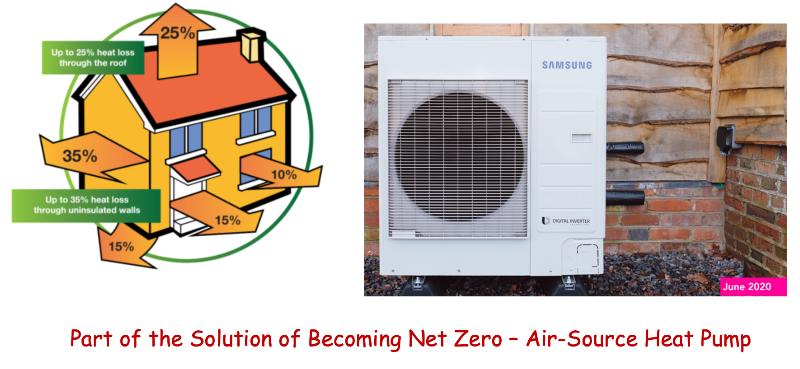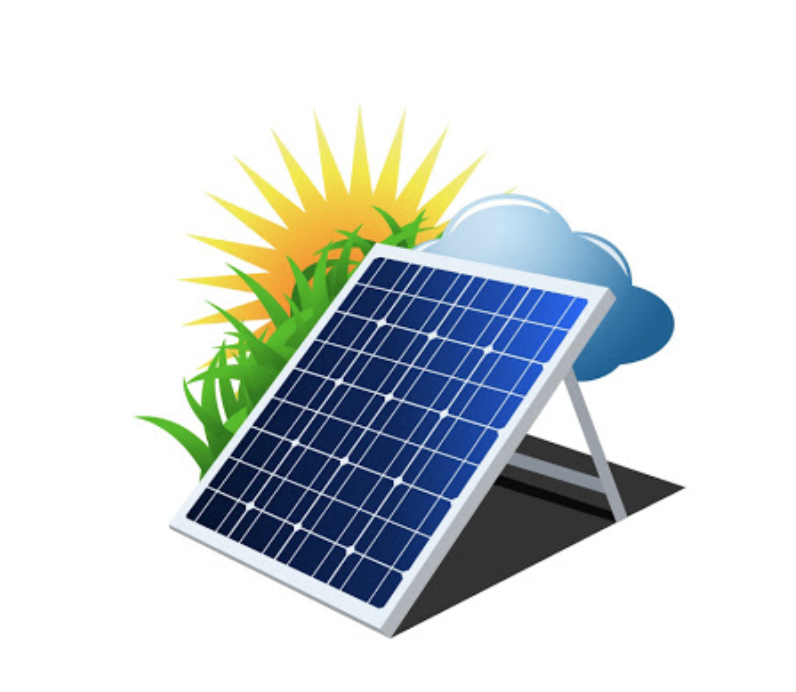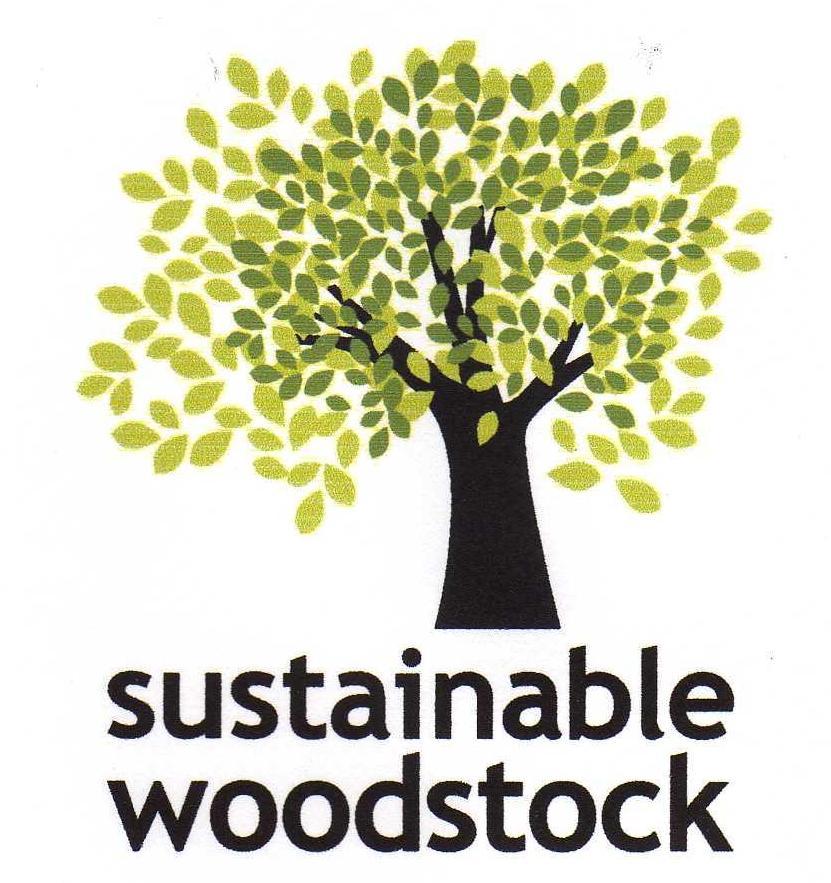Renewable Energy and Energy Conservation

Low Carbon Heating
A Step along the Road to Zero Carbon - by Darrell Marchand
Graham Brown has written about solar energy and how we can incorporate this into our homes to generate zero-carbon electricity to power our lights and appliances (see below).
The other main source of carbon
emissions from our homes is from the generation of heat and hot water.
In this part of the country, primarily this comes from burning natural
gas in boilers. Natural gas is a carbon fuel – less carbon intensive
than oil or coal, but a carbon fuel nonetheless. If there is any chance
of meeting the Government’s target of achieving net zero carbon
emissions by 2050, we simply have to move away from this fuel source for
heating.
But, in looking at what we can do in our own homes, the first step has
to be to manage the amount of energy we use. There are a number of
actions we can take and you have probably heard them many times over the
years. For many houses, they are still relevant, however.
Simple and inexpensive things like draught-stripping around doors and
windows to reduce the amount of cold air getting in and heat getting out
and setting your main thermostat to a level that reduces overheating.
More expensive things such as insulation (walls, roofs and sometime
floors) can generate good energy savings and return on investment as can
thermostatic radiator valves which regulate the amount of heat being
emitted by a radiator based on the temperature in that room. More modern
controls have been promoted in recent times – for example, ones that let
you control your heating via an app on your phone – and these may be
worth investigating. Of course, regular servicing of your boiler is
sensible on safety grounds and it will maintain your boiler’s operating
efficiency. On top of these options, a smart meter on your gas supply
will provide you with information about how much you are using when and
how much that is costing – a good way of monitoring and managing your
use. If you don’t yet have one, contact your gas supplier and ask them
to install one at your home (they are free).
Replacing your windows with more efficient versions are rarely viable on
energy-saving grounds alone but as part of a wider package of solutions
can be worthwhile and looking for the most efficient is certainly worth
considering if you planned to replace your windows for other reasons.
Once these items have been addressed, it is worth looking at the source
of heating. Alternatives to fossil fuels exist and although they are
still comparatively rare in the UK they are becoming more common. The
main ones being spoken about are heat pumps and hydrogen-fueled boilers.
Heat pumps are the front-runner. They are essentially reverse
refrigerators so they extract heat from outside and bring it into your
home – even in cold weather. The outside source can be the air, ground
or water with air likely to be the most relevant option for most
domestic situations. They use electricity to power pumps and compressors
to push a refrigerant gas around a closed system and can produce up to 3
or 4 units of heat for each unit of electricity they use. In most cases
that would heat the water that travels to your radiators. So, as the
country’s electricity supply increasingly turns to renewable sources
such as wind and solar, the emissions of carbon will reduce. A good
match would be solar panels on your roof alongside a heat pump. It is
likely that some other alterations to the heating system in your house
would be required as heat pumps don’t usually generate hot water at the
same temperature as a traditional boiler so you may need large radiators
for example.
Hydrogen as a fuel source is probably still a way off becoming a
large-scale solution as a number of challenges need to be addressed. But
it might come in time. The problem is we are constantly being told we
don’t have much time to make the necessary changes to avoid climate
disaster. Other options such as solar to directly heat water and
district heating schemes, where a large generating plant produces heat
that is pumped around a network of pipes taking heat to local
properties. These are more common in parts of Europe but rare in the UK.
And with the extensive work required to install them they are more
likely to be an option for new housing developments.
Installation cost is a major obstacle to adoption of heat pumps and they
are unlikely to generate long-term financial savings. The primary
benefit is environmental and all of the associated benefits that flow
from a cleaner environment. Hence, schemes such as the Green Homes Grant
(unfortunately, recently cancelled by the Government and remaining funds
transferred to a Local Authority scheme), that were set up to help with
the up-front costs and the Renewable Heat Incentive, that will pay for
heat generated much like the Feed in Tariff works for electricity. This
Green Homes Grant scheme was plagued by various problems and it seems
clear that if we have any chance of meeting our carbon targets, new,
well-thought out and planned schemes will be required probably using a
range of different incentives such as grants, tax adjustments, training
and education. Let’s hope they arrive soon.
Whilst the move to increase the amount of electricity generated from
renewable sources is positive, the transformation of our energy systems
(domestic heat referred to here but also electricity use for other end
uses such as electric vehicles) to become more reliant on electricity
means that this needs to continue at pace.
So, like many of the major challenges we face a combination of
individual action and larger Government and industry involvement is
required.
Sources of advice and help: Cosy
Homes and Renewable
Heat Incentive –
see Energy Saving Trust
*zero carbon can have several
definitions and how you account for overall environmental impact,
differing estimates of carbon emissions can be calculated
 Solar
Energy
Solar
Energy
Consider Collaborating with Nature
by Graham Brown
The good news is that solar panels are now cheaper (around 30% cheaper comparing 2011 to 2019) and more efficient (10% efficiency in 2011 compared to 18% today). Also, from the start of 2020, Ofgem has said that homes that put excess energy from their solar panels into the electricity grid will be guaranteed payment - a scheme called the Smart Export Guarantee. Depending on your electricity supplier this can be somewhere between 3-5p per kWh, not a great deal compared to the previous feed in tariff but something at least. This exported electricity will be measured by your smart meter. How much you export into the grid will depend on how much of the energy you use yourself. This is the most economical use as electricity currently costs around 14p/kWh so using your own will reduce the amount you will have to pay your electricity supplier.
In effect, although the payback for solar panels is greater when the feed in tariff scheme was in place, the return on investment is still 5% or more - where else are you going to get such a good return - certainly not from bank accounts. And don’t forget, the carbon emissions from installing solar panels are less than the emissions from the still largely fossil-fuelled grid electricity (even taking their manufacture into account).
Before installing a solar array there are a number of things to consider first.
* do you have a suitable south/southish facing roof?
* do you use a lot of electricity - do you run an electric car?
* can you time when your washer/dryer/dishwasher/car are used?
If you answer yes to the above then it is worth looking into solar panels. On sunny days you will be generating (and using) green energy, reducing your carbon footprint and saving on your electricity bill. Even on cloudy days the panels will be generating some electricity as it is daylight that activates the panels.
Batteries can also be installed in your house so power generated during the day can be stored and used at night. You could also use the electricity to heat your water. If you have an electric car there are schemes starting where your electricity supplier pays you to use your car battery to supply energy into the grid at peak times then charges your car when demand is low and energy is cheap - very smart!
With interest rates so poor at the moment it may be a good time to talk to a certified installer. A list can be found on the Microgeneration Certified website, ideally, the installer should be a member of the Renewable Energy Consumer Code.
Still wondering - for more information take a look at Martin Lewis's advice or the Energy Savings Trust

Sustainable Woodstock's Solar PV Scheme. Since our launch of the Solar PV scheme in July 2011, more than a dozen homes in the town have installed photo-voltaic panels and are reaping the benefits of free electricity and the feed in tarrif
Midland Felt Roofing,
In 2010, one of Woodstock's major employers, Midland Felt Roofing, moved to new premises. Their new offices and warehouse is located in the old Field Barn Farm buildings just north of the town as you head towards Chippy. Managing Director Paul Snell has specified the highest levels of energy efficiency for his new buildings. To read more about this textbook example of how to design energy efficient offices click here.
insert content here
 Sustainable Woodstock
Sustainable Woodstock